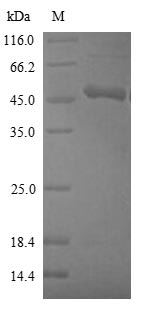Recombinant Human Cystathionine beta-synthase (CBS) is produced in a yeast expression system and includes a partial sequence covering amino acids 1-413. The protein carries an N-terminal 6xHis tag, which makes purification and detection more straightforward. Purity levels appear to exceed 90%, as confirmed by SDS-PAGE, suggesting this represents a high-quality reagent that may be suitable for various research applications.
Cystathionine beta-synthase (CBS) is an enzyme that plays a critical role in the transsulfuration pathway, helping to regulate homocysteine levels in the body. This enzyme catalyzes the conversion of homocysteine to cystathionine, a crucial step in sulfur amino acid metabolism. CBS has drawn considerable attention in biomedical research due to its involvement in various physiological processes and its connection to metabolic disorders.
Potential Applications
Note: The applications listed below are based on what we know about this protein's biological functions, published research, and experience from experts in the field. However, we haven't fully tested all of these applications ourselves yet. We'd recommend running some preliminary tests first to make sure they work for your specific research goals.
Based on the provided information, recombinant human CBS is produced in a yeast expression system as a partial fragment (1-413aa) with an N-terminal 6xHis-tag. CBS is a complex homotetrameric enzyme that requires proper folding, heme cofactor incorporation, and pyridoxal phosphate (PLP) binding for its catalytic activity. While yeast expression systems provide eukaryotic folding machinery that can support disulfide bond formation and some post-translational modifications, this partial fragment lacks the C-terminal regulatory domain (full-length CBS is 551aa), which is essential for proper tetramerization and regulatory function. The protein may not form the active tetrameric structure or properly incorporate essential cofactors. Purity >90% by SDS-PAGE under denaturing conditions does not confirm native folding or bioactivity. No validation data (e.g., enzymatic activity assays, cofactor analysis) are provided. Therefore, while yeast expression offers advantages over prokaryotic systems, the protein's folding status and bioactivity cannot be confirmed without experimental validation.
1. In Vitro Enzyme Kinetics and Biochemical Characterization Studies
CBS requires tetramerization and cofactor incorporation for activity; a partial fragment likely lacks proper function. If the recombinant CBS fragment is correctly folded and properly incorporates heme and PLP cofactors, it could be used for limited enzyme kinetics studies. However, if misfolded or lacking cofactors (likely without the C-terminal domain), activity assays would yield invalid results. The partial nature (missing regulatory domain) means any kinetic parameters measured would not reflect the physiological behavior of full-length CBS.
2. Protein-Protein Interaction Studies
The truncated form may not represent native interaction networks due to missing domains. If properly folded, the His-tagged CBS fragment could be used for interaction studies, but the missing C-terminal domain may eliminate key regulatory interactions. If misfolded, interaction domains may be altered, leading to non-specific binding or failure to identify genuine partners.
3. Antibody Development and Validation
Antibodies can be produced against linear sequences, but may miss full-length specific epitopes. This application is suitable, as antibody generation primarily relies on linear epitope recognition. The defined fragment provides specific epitopes for antibody production. However, antibodies generated against this partial fragment may not recognize conformational epitopes dependent on the full-length tetrameric structure.
4. Structural and Biophysical Analysis
Partial fragments provide limited structural insights for complex multidomain proteins. If properly folded, the fragment could provide insights into the N-terminal catalytic domain structure. However, the missing C-terminal domain limits understanding of full-length CBS architecture and regulation. If misfolded, structural data would misrepresent the native protein.
Final Recommendation & Action Plan
This yeast-expressed partial CBS fragment requires rigorous validation before functional applications due to the critical importance of the missing C-terminal regulatory domain for proper tetramerization, cofactor incorporation, and enzymatic activity. Recommended actions: (1) Validate folding through biophysical methods (circular dichroism, size-exclusion chromatography to check oligomeric state); (2) Test enzymatic activity with proper substrates and cofactors; (3) For reliable functional studies, use full-length CBS expressed in mammalian systems that can properly incorporate heme and PLP cofactors; (4) Antibody development can proceed but validate against full-length protein; (5) Structural and interaction studies should be interpreted with caution due to the truncated nature. Always include positive controls with validated full-length CBS when possible.






